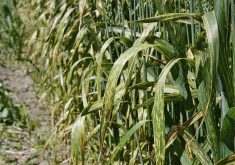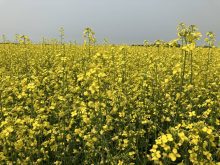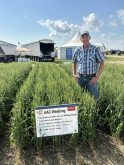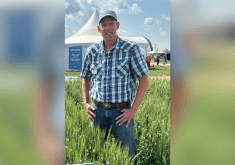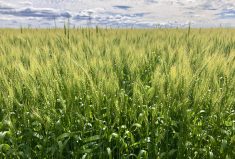Brian Buckman really only has Mother Nature to thank — or blame — for the gap between the yield he’s getting and what’s possible on his wheat fields.
“A perfect example was 2020 — we hit it out of the ballpark with the best yield we ever had, and then in 2021, we saw the worst yield we ever had,” said the Nobleford-area farmer.
“In 2020, we saw 85 to 90 bushels per acre, and in 2021, we had six to eight bushels an acre. These drastic changes really keep us thinking.”
Read Also

Hail research hopes to benefit potato growers
Alberta research scientist measures hail storm and heat dome affects on potato crops
Every year, Buckman tries to tick off the boxes that will help close the yield gap in his spring wheat crop. He employs a four-year rotation (alternating cereals, oilseeds, and pulses), soil tests to determine residual nutrients, and applies fertilizer and other inputs at the right time.
But because he’s a dryland farmer in a relatively dry area, his yield is “so dependent on the weather.”
“We adjust our practices as much as we can as long as it’s cost effective,” said Buckman. “We soil sample every year and plan for a 40- to 50-bushel-an-acre crop, but it sure can vary.
“We can plan all we want for optimum production, but if Mother Nature doesn’t give us the rain, we have to be really careful.”
Last year really brought that lesson home when Buckman tried to top-dress his fertilizer application before it rained — and then didn’t get any rain.
“You know southern Alberta weather — it can change in a heartbeat,” said Buckman. “Last year, we got caught because we put lots of fertilizer down thinking it was going to be a good year, and then the end of June hit and our temperatures (ranged) from 30 to 35° for two weeks straight. That hurt us.”
But a new study aims to take the guesswork out of closing the yield gap for Prairie farmers.
“The project goal is to identify the key factors that prevent CWRS wheat producers from obtaining the yields that are potentially achievable on farms,” said Sheri Strydhorst, agronomy research specialist with Alberta Wheat and Barley, one of the groups funding the research.
“In Canada and the U.S., lots of wheat is produced, but still, both countries rarely surpass average yields of 50 bushels per acre. We know that much more potential is out there.”
Yield potential can be tricky to measure, but essentially, it’s the maximum you can expect “when there aren’t limitations from water or nutrients or damage from pests and diseases,” said Strydhorst.
Those potential yields will vary based on the time and the location, but international studies have found that, in general, yields are between 40 and 70 per cent of their potential.
“That means there’s a lot of yield that farmers are potentially missing out on,” said Strydhorst.
Some of that potential could only be gained by spending like crazy on inputs, but a fair-size chunk of it is achievable, she said.
“Producers could economically increase their yields by 10 to 40 per cent with improved management. That’s why we want to do this — to help farmers close that yield gap while being economical and environmentally sound.”
Low-hanging fruit
The research team, led by senior federal research scientist Brian Beres, is looking at the agronomic causes of these yield gaps by surveying farmers across the Prairies about their production practices.
The goal is to determine what gives them the best bang for their buck.
“We don’t want producers spending money on practices that don’t make economic sense,” said Strydhorst. “Once we get enough data together, if we see for instance that the lower-yielding fields tend to have lower plant populations, then that information can be communicated to the broader industry.”
As part of this project, the research team is hoping to survey a broad selection of producers and conduct an in-depth analysis of their CWRS wheat production data from 2019 and 2020 on both dryland and irrigated fields.
“What works in Oyen might not necessarily be what’s needed in Lacombe, so the study is broken out into seven different geographic zones where there’s similar soil and rainfall conditions,” said Strydhorst. “We’re trying to understand within each of those geographic areas what would be beneficial.”
Buckman, who is participating in the study, sees the value in these regional results.
“We can have a rainfall that, from home to 25 miles away, can range from two or three inches to nothing, depending on where the storms go,” he said.
The survey includes questions about variety; yield; quality; timing of seeding and harvest; input applications and rates; and any weather events, among other agronomic information. That data will be analyzed in collaboration with Kansas State University’s Global Yield Gap Atlas, which has been used to estimate yield gaps in 15 crops in 62 different countries.
“We’re working with a system that’s really highly proven, but there hasn’t been this information on yield gaps on the Canadian Prairies yet,” said Strydhorst.
“With this compiled data, the hope is really to give producers that direction that they can implement to improve management practices that will make the biggest impact on their yield.”
Those practices will vary from farm to farm, but with this survey and data analysis, spring wheat growers will be better prepared to identify — and close — the yield gap on their own operations.
“Everyone always wants to do better, but sometimes you don’t know what the low-hanging fruit is — the best things to do that will make the most difference in your yields,” said Strydhorst.
“I think at the end of the day, it will help farmers zero in on what agronomic practices are most critical to improve on their operation. It really prioritizes where effort should be spent to get the best returns from their improved management.”
To learn more about the project or to complete the survey, visit farmingsmarter.com.



